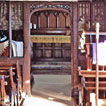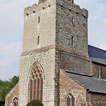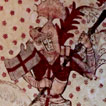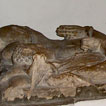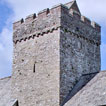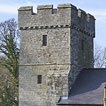The Parish in the Later Middle Ages
The Middle Ages saw most parish churches rebuilt several times, at least in part. From the 13th century onwards, masons were experimenting with new ways of building. The rounded arches and heavy masonry of Norman architecture fell out of favour. Pointed arches became the new norm, and as time went by the masons gained the confidence to build walls thinner and make windows bigger and bigger. Architectural historians in Britain recognise three main periods of architecture between the early 13th century and the early 16th century. Early English architecture in the first half of the 13th century, with fairly narrow pointed arches, groups of lancet windows and restrained ornament, gives way around the middle of the century to a much richer style, known as Decorated, more heavily ornamented with cusping everywhere and h increasingly complex tracery for large windows. After the Black Death in the middle of the 14th century, the fashion in Britain changed to an emphasis on the vertical, which gives the new style its name of Perpendicular.
In some villages the masons working on the churches seem to have been based fairly locally. It is unlikely that they had the experience to attempt the more complicated aspects of the new fashionable styles, and the results are fairly plain. Sometimes the only way to tell that a church has been built at the end of the 13th century rather than the beginning is that the lancets have been built with cusped heads. However, in some parishes we can see a possible connection between the architecture of the church and the castle, and it looks as though the local lord has employed more cosmopolitan masons.
The most important activity to take place in the church was the mass. Mass was celebrated by the priest in the chancel behind the rood screen, with the congregation receiving communion only occasionally. However, congregations were very much involved in the life of their church, and were very active in raising money to beautify it. There would have been an abundance of wall-paintings , stained glass and carvings in wood and stone of saints and Christian symbols, designed to instruct the illiterate and act as a focus for devotion. Some of these embellishments, particularly chantry chapels, were linked to the practise of saying masses for the dead, to lessen their time in Purgatory.
